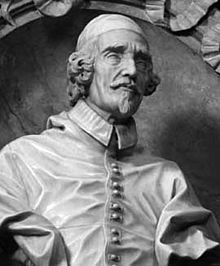Michelangelo Ricci
Michelangelo Ricci (born January 30, 1619 in Rome , † May 12, 1682 ibid) was an Italian cardinal and mathematician.
Ricci, like his friend Evangelista Torricelli, was a student of Benedetto Castelli , professor of mathematics at the University of Rome and friend of Galileo Galilei . Torricelli taught Ricci and other students when Castelli from Rome was absent on his behalf. Ricci mainly studied law and theology, where he befriended the mathematician René de Sluze , who also studied law there. After that Ricci worked for the Catholic Church (without ever being ordained a priest), was secretary of the Congregation for Indulgences and Relics , was an advisor to the Congregation for the Doctrine of the Faith (Inquisition) and was even appointed in September 1681 by Pope Innocent XI. elevated to cardinal status (which he initially resisted). Shortly thereafter, in 1681, he was appointed cardinal deacon of Santa Maria in Aquiro .
In these functions he endeavored to dampen confrontations between the Church and the developing modern natural sciences (as escalated in the case of Galileo). For example, he corresponded with the Church of officially acceptable formulations with the Galileo student and physicist Vincenzo Viviani , when he was writing a biography of Galileo.
Today he is best known for his mathematical publication Exercitatio geometrica, De maximis et minimis from 1666 (also reprinted as an appendix to the Logarithmo-technica by Nicolaus Mercator in 1668). It is dedicated to the scholar Stefano Gradi (Stjepan Gradić; 1613–1683), curator of the Vatican library. In it it determines the maximum of and the tangent of . There is also an early example of complete induction . His reputation as a mathematician among his contemporaries was based primarily on his correspondence with, among others, Torricelli, Christophorus Clavius , Viviani and De Sluze, in which Ricci results, for example, on generalizations of cycloids and spirals . In a letter from 1668 there is an explicit formulation of the fundamental theorem of analysis (tangent and area determination as mutually inverse operations). Torricelli informed him by letter of his barometer experiments and Ricci discussed them with Marin Mersenne when he visited Rome in 1644.
A manuscript on algebra in Genoa shows his familiarity with algebraic research in the sequel of François Viète .
Bonaventura Cavalieri originally wanted Torricelli (who also died soon afterwards) and Ricci to publish his posthumous writings, but Ricci did not find the time.
He was a corresponding member of the Medical Accademia del Cimento in Florence (to which Viviani and others belonged) and was also in correspondence with Leopoldo de 'Medici . In 1668, together with Giovanni Giusto Ciampini (1633–1698) and Francesco Nazari (1634–1714), he founded the journal Giornale de letterati, which he published in 1675. He belonged to the circle of the abdicated former Queen Christina of Sweden in Rome.
Ricci suffered from epileptic seizures all his life .
He is buried in the church of San Francesco a Ripa in Rome.
Web links
- John J. O'Connor, Edmund F. Robertson : Michelangelo Ricci. In: MacTutor History of Mathematics archive .
- Ricci, Michelangelo. In: Salvador Miranda : The Cardinals of the Holy Roman Church. ( Florida International University website), accessed July 26, 2016.
| personal data | |
|---|---|
| SURNAME | Ricci, Michelangelo |
| BRIEF DESCRIPTION | Italian cardinal and mathematician |
| DATE OF BIRTH | January 30, 1619 |
| PLACE OF BIRTH | Rome |
| DATE OF DEATH | May 12, 1682 |
| Place of death | Rome |



